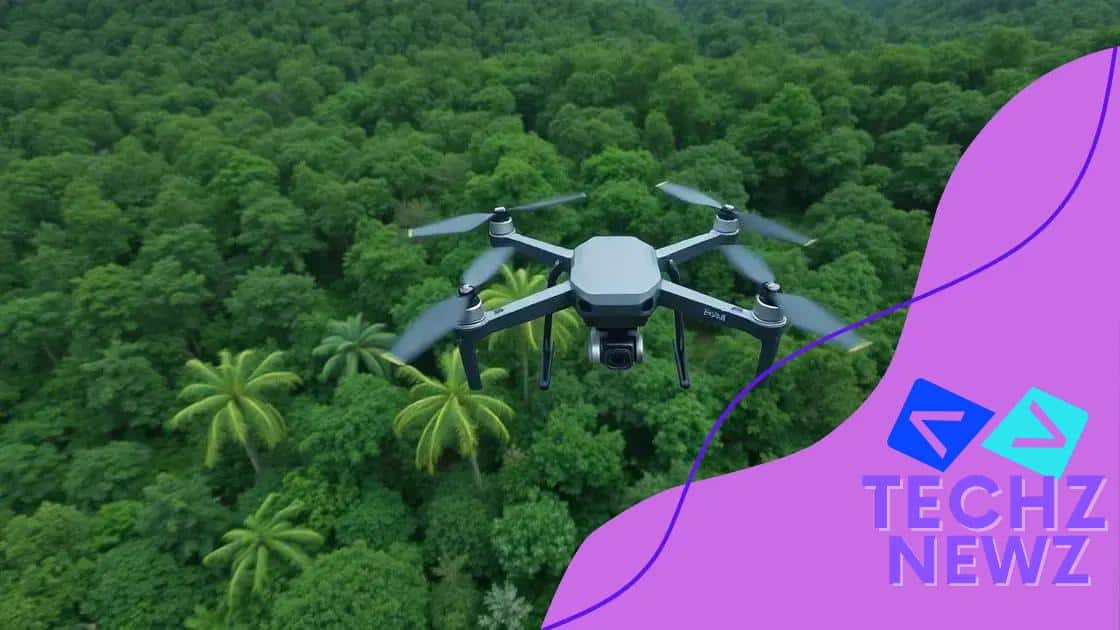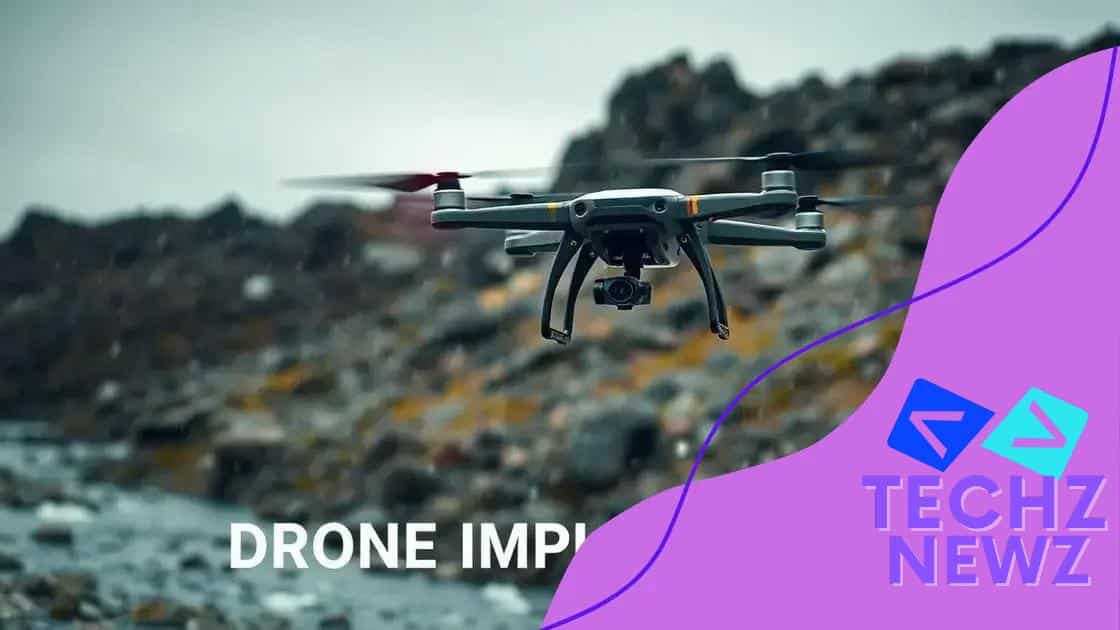Drones used in environmental monitoring and conservation

Drones used in environmental monitoring and conservation provide essential data for protecting ecosystems, offering cost-effective, real-time insights while overcoming challenges like regulatory hurdles and public perception.
Drones used in environmental monitoring and conservation are transforming how we protect our planet. Have you considered how these advanced tools can provide crucial insights into ecosystem health? In this article, we’ll explore their impact on conservation efforts.
Understanding drones in conservation
Understanding drones in conservation is crucial for anyone interested in protecting the environment. These innovative tools allow experts to gather data in ways that were once unimaginable.
The use of drones provides a bird’s-eye view of landscapes, helping to monitor wildlife, track deforestation, and assess the health of ecosystems. This technology can cover large areas quickly and efficiently, making it an essential asset in conservation efforts.
Key Uses of Drones in Conservation
Drones are revolutionizing the way conservationists gather information. Here are some primary applications:
- Wildlife monitoring: Drones can track animal movements and populations without disturbing them.
- Forest management: They provide detailed imagery that helps in assessing tree health and planning sustainable logging.
- Pollution assessment: Drones can quickly identify and map pollution sources, assisting in targeted clean-up efforts.
As technology evolves, drones are becoming increasingly sophisticated, equipped with various sensors and cameras. These features enhance the data collection process, allowing researchers to make informed decisions based on accurate information.
Another fascinating aspect of drones in conservation is their ability to access remote or challenging terrains. Dense forests, rugged mountains, or vast wetlands can pose significant challenges for researchers. With drones, getting crucial data from these areas becomes a much simpler task.
Furthermore, drones can be used in community engagement efforts. By showcasing real-time data and mapping results, conservationists can collaborate with local communities to address environmental issues effectively. This partnership is vital for successful conservation strategies.
Benefits of drone technology for environmental monitoring
The benefits of drone technology for environmental monitoring are profound. This innovative approach allows for more effective data collection, contributing significantly to conservation efforts.
One of the primary advantages is increased accessibility. Drones can reach areas that are difficult or impossible for humans to access. This capability enables researchers to gather critical data from remote locations, ensuring a comprehensive understanding of ecosystems.
Key Advantages of Using Drones
There are several key benefits that make drones ideal for environmental monitoring:
- Cost-effectiveness: Drones reduce the need for expensive helicopter surveys, enabling budget-friendly data collection.
- High-resolution imagery: They provide sharp images and detailed maps, helping to identify changes in landscapes over time.
- Real-time data collection: Drones can transmit data instantly, allowing for immediate analysis and quicker decision-making.
Additionally, drones are versatile and can be equipped with various sensors to monitor different environmental factors, such as temperature, humidity, and vegetation health. This adaptability makes them essential tools for scientists and conservationists alike.
The integration of drones into environmental monitoring also enhances public engagement. By sharing data and images with the community, local stakeholders can better understand the health of their environment and participate in conservation initiatives.
As technology advances, the capabilities of drones continue to expand, opening new possibilities for research and monitoring. Their effectiveness in tracking wildlife and assessing habitat conditions cannot be understated.
Challenges faced in drone implementation

Despite the significant advantages, there are also several challenges faced in drone implementation for environmental monitoring. These obstacles can impact how effectively drones are used in conservation efforts.
One major challenge is regulatory compliance. Each country has its own rules governing drone use, which can complicate data collection efforts. Navigating these regulations often requires time and careful planning.
Key Challenges in Drone Implementation
Understanding these challenges is essential for successful drone operations:
- Technical limitations: Drones may have restricted battery life, limiting operational time and range.
- Weather conditions: Adverse weather can hinder drone functionality, affecting data collection.
- Data management: Analyzing the large amounts of data collected can be overwhelming without the right tools and skills.
Another challenge involves public perception. Some communities may be wary of drones, questioning their privacy or safety. Educating the public about the benefits of using drones for conservation is crucial in addressing these concerns.
Moreover, the initial cost of purchasing and maintaining drones can be high, which may deter smaller organizations from adopting this technology. Understanding the long-term benefits and potential funding opportunities can help overcome this barrier.
Technology also constantly evolves, leading to the challenge of keeping up with advancements. Staying updated is essential for maximizing the effectiveness of drones in environmental monitoring.
Case studies of successful drone usage
Case studies of successful drone usage provide valuable insights into how this technology aids environmental monitoring and conservation. Various organizations have reported impressive outcomes through innovative applications of drones.
In one notable example, researchers in Madagascar used drones to monitor the endangered lemur population. By capturing aerial images, they could identify habitats and measure vegetation health, leading to effective conservation strategies.
Noteworthy Applications of Drones
Several successful implementations highlight the diverse capabilities of drones:
- Coral reef monitoring: Scientists in Australia deployed drones to assess coral health and track changes due to climate change.
- Wildfire tracking: In the United States, drones have been used to monitor wildfires, helping to coordinate firefighting efforts more effectively.
- Forest conservation: Drones in Brazil have assisted in tracking illegal logging activities, providing data to enforce environmental laws.
These case studies demonstrate how drones not only aid in research but also foster community involvement and education. Local communities become more engaged when they see tangible results achieved through this technology.
Furthermore, successful drone usage often leads to collaborations among researchers, governments, and NGOs, creating a network focused on preserving natural resources. This synergy enhances the impact of conservation projects, as multiple stakeholders contribute to shared goals.
As these examples show, the potential for drones in conservation is enormous, paving the way for innovative solutions to urgent environmental challenges.
Future trends in drone conservation efforts
Future trends in drone conservation efforts are shaping the way we protect the environment. As technology advances, drones are becoming more efficient and versatile, offering new possibilities for conservationists.
One significant trend is the integration of artificial intelligence (AI) into drones. AI allows for smarter data analysis, enabling real-time decision-making during field operations. By analyzing images and sensor data on the fly, drones can identify patterns and changes in ecosystems much faster than humans.
Emerging Technologies in Drone Conservation
Several emerging technologies are enhancing the capabilities of drones:
- Advanced sensors: New lightweight sensors can detect various environmental conditions, improving monitoring accuracy.
- Swarming technology: Multiple drones can work together, covering larger areas and helping in large-scale surveys.
- Enhanced battery life: Longer-lasting batteries will extend operational time, allowing for more extensive data collection in single missions.
Another trend is increased collaboration among organizations. Research institutions, governments, and NGOs are coming together to share resources and expertise, leading to more comprehensive conservation strategies. This teamwork can amplify results and drive innovative projects forward.
There is also a shift toward involving local communities in conservation efforts. Educating residents about how drones can positively impact their environment will foster a sense of ownership and responsibility. Community engagement ensures sustainable practices that align with the needs and values of local populations.
Finally, as regulations evolve, drones will become easier to use in conservation. Streamlined permits and clearer guidelines will encourage more organizations to adopt this technology, leading to broader applications in environmental monitoring and wildlife protection.
Conclusion: Drones have revolutionized the field of environmental monitoring and conservation. By providing a unique perspective and collecting valuable data, these flying devices play a crucial role in protecting our planet. As technology continues to advance, the future of drone conservation looks bright. Collaborations among communities and organizations will strengthen conservation efforts. Engaging local populations and embracing new technologies, like AI, will enhance the effectiveness of drones. Together, we can ensure a healthier environment for future generations.
FAQ – Frequently Asked Questions about Drones in Environmental Monitoring
How do drones improve data collection in conservation efforts?
Drones provide a unique aerial perspective, allowing for the collection of high-resolution images and various environmental data quickly and efficiently.
What are the main benefits of using drones for environmental monitoring?
Drones are cost-effective, can access hard-to-reach areas, and collect data in real-time, which enhances decision-making in conservation.
What challenges do organizations face when implementing drone technology?
Challenges include regulatory compliance, technical limitations, and public perception regarding privacy and safety.
What future trends should we expect in drone conservation efforts?
Future trends include the use of AI for smarter data analysis, enhanced sensors, and increased collaboration among organizations and communities.





